BBC | How light could help superfast mobile reach even further
BBC Speaks with our CCO Harald Burchardt about our partnership with O2 and the future of LiFi
Chris Baraniuk BBC Technology Reporter
The global race towards superfast “fifth generation” mobile internet, known as 5G, is entering a key phase. The trouble is no-one knows exactly which technologies will be best for offering such a service. But one telecoms firm may just have had a light-bulb moment.
At its headquarters in Slough, O2 has installed an unusual demo. It’s a room where a wireless internet connection is provided not through wi-fi, but LiFi – a system that transmits data through light waves rather than radio waves.
The mobile operator thinks the system may help to offer 5G speeds in certain locations where getting coverage from an outdoor mobile signal is difficult.
Harald Burchardt of pureLiFi, the firm behind the tech, says ceiling spotlights in the room have been spaced evenly so that their downward, cone-shaped beams can connect to a light-receiving dongle plugged into a tablet computer.
“We’re using the light itself,” he tells me, gesturing at the bulbs above. “These are flickering at billions of times a second, naked to the human eye.”
LiFi can offer data speeds of up to eight gigabits per second (8Gbps) – about 400 times faster than the average broadband speed in the UK.

You need only walk a few steps out of the room and the signal drops. Inside, it stays ultra snappy.
Within the ceiling, the light bulbs have been connected to access points that are wired to the internet. If you didn’t know that, though, you’d simply think you had walked into a well-lit room. It’s a much more market-ready version of the technology demonstrated to the BBC four years ago.
So why is O2 considering li-fi as a potential way of offering 5G-style mobile connectivity in indoor spaces?
“Targeting indoor coverage is a real challenge,” explains Brendan O’Reilly, O2’s Chief Technology Officer
This is because it is harder for high-frequency, short wavelength 5G radio signals to penetrate walls and windows than 4G radio signals. Despite ostensibly being faster, the 5G signal may actually be less accessible in some places as a result.
“Li-fi could be part of a 5G solution. It provides good data rates,” says Mr O’Reilly.
“I don’t think we’ll see O2 necessarily offering to make light bulbs themselves, but as part of a solution to a connectivity problem I can see li-fi playing a role in that.”
LiFi could extend mobile connectivity into those hard-to-reach indoor spaces. Or li-fi bulbs could replace streetlights in well-lit urban areas to provide high-speed connections to densely packed crowds of people.
Last year, Harald Haas, who coined the term “li-fi”, published a paper in which he described the technology as a game-changer for 5G, listing a number of potential applications.
It might connect “internet of things” devices dotted around a building via light, he argued, offer connectivity to driverless cars moving along roads, or bring super-fast wireless internet to devices in data centres.
And Mr O’Reilly suggests that hospitals could easily hook up healthcare devices to the local network without having to rely on over-burdened wi-fi networks or relying on potentially hazardous cables.
Click here to read the full article

